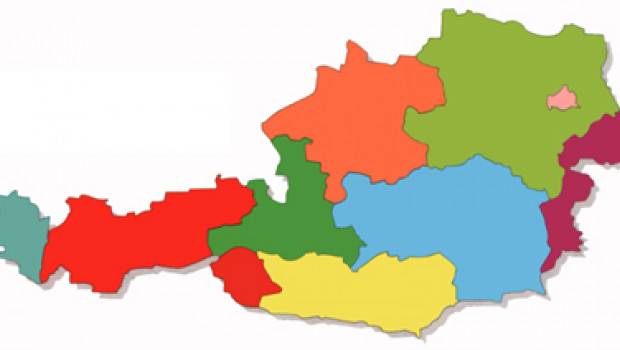Since the mid-nineties the amount of retail area occupied by DIY stores in Austria has almost doubled. The DIY store density varies greatly from one federal state to another. Leading the field is Lower Austria, with Vorarlberg bringing up the rear
Austria and its federal states
Regional structure of the DIY stores
The distribution of the DIY stores across the Austrian states shows considerable variations, especially where the density of retail space is concerned, when comparisons based on the new (but interim) population figures from the 2001 national census are made.
The 252 DIY stores listed are outlets of the following DIY retail groups: Bauhaus, Baumax, Hagebau (incl. Quester), Hellweg, Hornbach, OBI, Öbau, Praktiker and the Idee line of 3E-AG. Not included were around 20 small DIY stores, which do not belong to any DIY group, and the 13 AFS DIY stores, with a total of 30 000 to 35 000 m² between them. The retail areas have almost all been weighted in accordance with BHB (Federal Association of German DIY, Building and Garden Stores) rules, with the exception of Öbau.
The number of DIY stores has scarcely risen since the mid-nineties, but the area taken up by DIY stores has almost doubled since then to 1 079 500 m². There have indeed been various new openings, but as a rule this happened at the expense of closing down small, uneconomical outlets. The extension of existing DIY stores has played the main role in recent years for most DIY multiples.
The area density of DIY stores in Austria overall, however, with 7.5 inhabitants per m² of retail area has not yet reached the comparable figure in Germany (5.4 inhabitants per m²); however, individual federal states like Lower Austria, Carinthia and Styria are already coming close to it. Area density is calculated both from the number of inhabitants per square metre of DIY retail area and from the relationship between the proportion of the total population to the proportion of overall DIY area in the respective federal state. The average DIY store area for the ten named DIY groups currently stands at 4 284 m².
Lower Austria has the greatest space density (5.7 inhabitants per m² of retail area), but this state must be seen in conjunction with the federal capital of Vienna; here the area density is very low (12.3). In 2001 253 000 second homes were recorded for Lower Austria; these mainly belong to families from Vienna, who make their purchases of DIY articles where their weekend cottages or holiday homes are.
Vienna is undersupplied with DIY retail space, but the inhabitants here are mainly the occupants of blocks of flats, whose annual purchases in DIY stores are considerably lower than the purchases made by owner-occupiers with gardens.
In Upper Austria, the third largest state, the area density is slightly below average. The fourth largest state, Styria, is well known for the great amount of interest its inhabitants show in their homes and gardens, and especially in DIY activities. The DIY retail area density is correspondingly high (6.0). A relatively high density is also evident in Carinthia. Salzburg and Burgenland have a relatively proportionate share of the total retail area.
The low area density in the traditional tourist regions of Tyrol and Vorarlberg is striking. Here there are many private individuals who let rooms, but who for tax reasons require invoices from the relevant tradesmen for their renovations. For many years do-it-yourself has not had such a strong presence here as in the other states. The Austrian franchise partners of OBI and Hagebau are most strongly represented in Tyrol – this corresponds to the Tyrolean mentality, which is not happy to accept foreign businesses.
(pdf file download)
Regional focus of the DIY groups
Market leader Baumax has a 34 per cent share of the overall retail area and is represented in all the federal states. It enjoys a dominant position in Lower Austria, Upper Austria and Salzburg, and is very strong in Vienna and Carinthia as well. OBI’s share is about 18 per cent; there are no OBI stores in Salzburg or Vorarlberg. OBI’s position is strong in Vienna, Lower Austria, Styria, Carinthia and Tyrol. OBI is the market leader in Burgenland.
The Austrian group Öbau is represented everywhere with the exception of Vorarlberg. Its share by retail area is 16 per cent and it is clear that its main focus is on Lower Austria and Styria, where Öbau is stronger than Baumax.
Hagebau, too, is represented in all the Austrian states with its typical neighbourhood stores; it has a 10 per cent share of the total retail area. Hagebau now has well-developed focal points in Styria and Upper Austria through its new member Quester (including Stadlbauer). In Tyrol, where this Hagebau member comes from, it ranks second behind OBI.
Bauhaus is represented throughout Austria, with the exception of Burgenland, with its main focus on the bigger towns and cities. Bauhaus has a 9 per cent share of total retail area and its regional strength lies in Vienna, Upper Austria and Lower Austria; its position in Styria has also been considerably improved.
Through new openings in 2001 Hornbach has achieved around 8 per cent of total retail area with just seven stores. Its main focus is in Lower Austria, where Hornbach ranks third with outlets located on the Viennese border. The DIY groups that have not been mentioned are located in a number of different states.
Austria
Population: 8.07 mio
Area: 84 000 km²
Rate of inflation 2000: 1.8 %
Rate of unemployment 2000: 3.7 %
Gross domestic product 2000: 288 bn
Real change to GDP 2000: 3.6 %










